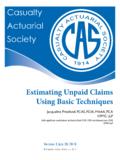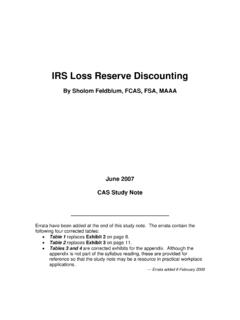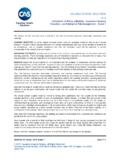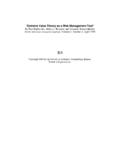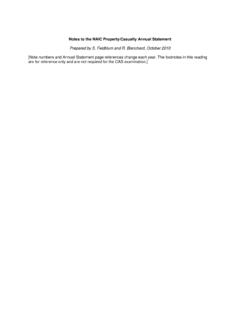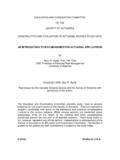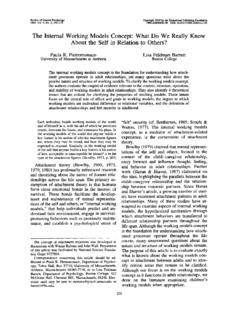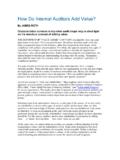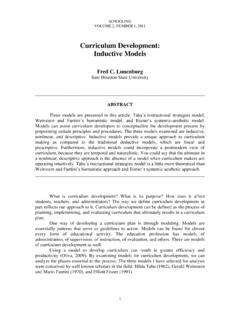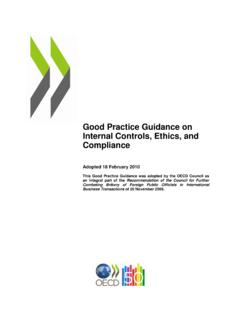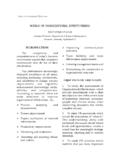Transcription of PRICING INSURANCE POLICIES: THE INTERNAL …
1 PRICING INSURANCE policies : THE INTERNAL RATE OF RETURN model Shoiom Feidbium (May 1992) Financial models, which consider the time value of money, surplus commitments, and investment income, are increasingly being used in INSURANCE rate making. This reading shows how an INTERNAL rate of return model can be used to price INSURANCE policies . it discusses the framework of the IRR model , the various INSURANCE , investment, and tax cash flows, the surplus commitments and equity flows, and two methods of estimating the opportunity cost of equity capital. it presents an application of the IRR model from a recent Workers Compensation rate filing.
2 Finally, it discusses the potential pitfalls in using IRR PRICING models. [This study note was written as educational material for the Part 10A CAS examination. The tables in Section V are reproduced with permission of the National Council on Compensation INSURANCE . The views expressed here do not necessarily represent the position of the Casualty Actuarial Society, the Liberty Mutual INSURANCE Company, the National Council on Compensation INSURANCE , or of any other organization. I am indebted to Robert Butsic, Richard Woli, and David Appei for numerous suggestions and comments on using IRR models, and to Charles Walter Stewart, Paul Kneuer, Jonathan Norton, John Koiiar, Ira Robbin, John Coffin, Steve Lehmann, Paui Braithwaite, Leigh Halliwell, Wiiliam Kahiey, Len Gershun, Gerald Dolan, and Peter Murdza for extensive editing and corrections to earlier drafts of this reading.]
3 The remaining errors, of course, are my own.] PRICING INSURANCE policies : THE INTERNAL RATE OF RETURN model - Table of Contents Section I: introduction .. , .. , . , .. , , .. , , .. , I PointofView ..2 A Non- INSURANCE Illustration of the IRR model .. 3 INSURANCE IRR Models.. 4 Equity Flows ..5 An Equity Flow Illustration.. 7 Section II: Cash Flows.. , ..9- A. Premium Cash Flows ..9 Premium Collection Patterns .. 9 RLossCashFlows .. 11 Payment Lags .. 11 Loss Adjustment Expenses .. 12 .. 13 Types of Expenses.. 14 D. investment Cash Flows .. 15 Investment Yield and INTERNAL Rate of Return.. 1 6 Taxes on Investment Income .. 17 E, Federal Income Taxes.
4 18 Section Ill: Surplus .. , .. : ..20 The Individual Firm and the Industry.. 20 Surplus Allocation .. 2 1 Premiums and Reserves.. 22 Long- and Short-Tailed Lines .. 23 INSURANCE Risks.. 23 Policy Type.. 25 Section IV: The Cost of Equity Capital.. , .. 2 6 TheDividendGrowth model .. 1.. 26 Derivation of the DGM .. 27 Changes in Dividend Growth Rates.. 2 8 Stock versus Mutual Insurers.. 2 9 Capital Asset PRICING model .. ; .. 30 Price Fluctuation.. 3 0 Section V: A Rate Filing Illustration .. 3 2 Assumptions-Table I .. 32 Cash Flows-Table II.. 33 Investment Yield - Tables III-A and Ill-B.. 1 .. 34 Cash Flows Supporting Reserves - Table IV.
5 3 5 TaxCredits-TableV-A ..36 Cash Flow from Underwriting - Table V-B ..* . 3 8 Surplus Funds and Invested Assets - Table VI.. 3 9 Equity Flows-Table VII.. 39 Exhibits Table I: Assumptions..4 1 Table II: Cash Flow Patterns .. 4 2 Table III-A: Total Estimated Yield for Composite Portfolio.. 4 3 Table III-B: Pre-Tax and Post-Tax Yields.. 4 4 Table IV: Cash Flows for Loss and Unearned Premium Reserves .. 4 5 Table V-A: Tax Credits from Underwriting Operations.. 46 Table V-B: Net Cash Flow from Underwriting .. 4 7 Table VI: Cash Level and Funds in Surplus Account .. 4 8 Table VII: Nominal Cash Flow to Investors.. 4 9 Section VI: Potential Pitfalls in IRR Analyses.
6 , .. , .. , ,.. 5 0 General Criticisms .. 5 0 Cash Flow Patterns.. 5 1 Oversimplifications .. 5 2 Mutually Exclusive Projects and Reinvestment Rates.. 5 3 Practical Criticisms .. ! .. 5 4 Premium Inadequacies and IRR Analyses.. 5 5 Section VII: References .. , .. ,_.. , .., .. 5 7 I I PRICING INSURANCE PCjLiClES: THE INTERNAL RATE OF RETURN model Section I: Introduction How should an actuary determine premium rates for INSURANCE policies ? Early rating bureau PRICING procedures incorporated a fixed underwriting profit margin, such as for Workers Compensation and 5% for other lines of business. The simplicity of this approach led to its continued use by the actuarial profession.
7 During the past two decades, economists, financial analysts, and casualty actuaries have proposed alternative PRICING models, sparked by the lack of theoretical justification for the traditional procedure, the high interest rates in the American economy, and the increasing competitiveness of the INSURANCE industry. More precisely, the stimuli for more accurate PRICING models fall into three categories: ( 1 ) Tfie time value of money: INSURANCE cash flows on a given contract occur at different times. Of&en, premiums are collected and expenses are paid at policy inception, whereas losses are settled months or years later. Monies exchanged at different dates have different values, which we relate to economic inflation, available interest rates, or the opportunity cost of capital.
8 Financial INSURANCE PRICING models consider both the magnitudes and the dates OF cash transactions. ( 2 ) Competition and expected returns: In a free market economy, the price of a product depends on the degree of competition in the industry. If a firm prices its product above the market level, it may lose sales. If it prices its product below the market level, its profits may fall. The optimal price for products whose costs are known in advance of the sale is determined by production costs and competitive constraints. Complex INSURANCE products, however, require an a priori analysis of both expected costs and achievable returns. ( 3 ) The rate base: The underwriting profit margin is a return on sales.
9 Businessmen in many industries measure profits in relation to sales, though this method is not favored by financial analysts and theoretical economists. Alternative rate bases are assets, which are used in public utility rate regulation, and equity (or net worth), which is used in most financial PRICING models. There is a wide divergence between the underwriting profit margins assumed in rate filings and actual INSURANCE experience. Over the past 15 years, underwriting profit margins have averaged about -7%, despite the +5% or + assumed in rate filings. Much of this discrepancy stems from regulatory disapproval of requested rate revisions.
10 In addition, some insurers do not always target a positive underwriting profit margin, since the resultant rates may not be competitive. Actuaries have responded with new, more sophisticated PRICING techniques, which consider cash flows, financial constraints, and competitive pressures. Many insurers analyze their 1 performance with realistic profitability models. But the documentation and dissemination of these models, whether in minutes of technical rating bureau committee meetings or in academic articles, has been sparse. The practicing actuary needs a clearer exposition of the various PRICING models. This paper describes the INTERNAL Rate of Return (IRR) INSURANCE PRICING model .

